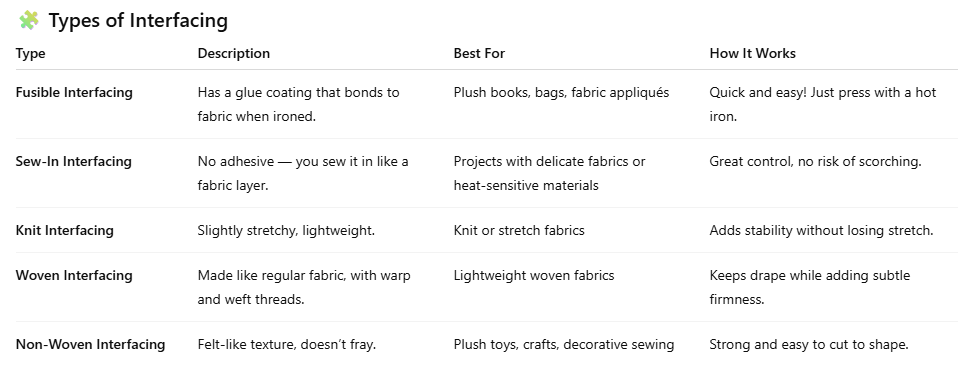Sew Strong! Why Interfacing Might Be the Secret Ingredient Your Projects Have Been Missing
Ever sew a project that feels a little too floppy? Or work with a fabric that frays faster than your patience? That was me before discovering interfacing — and now, I can’t imagine sewing without it!
When I first started using flannel for my plush book patterns, the edges would fray like a bad breakup. But once I fused on some interfacing — boom! — clean edges, stable seams, and professional-looking results. Interfacing quickly became my sewing sidekick.
So, what exactly is interfacing, and why does everyone seem to swear by it? Let’s iron out the details (pun fully intended).
🧵 What Is Interfacing?
Interfacing is a material added to the wrong side of fabric to give it more structure, stability, and strength. Think of it as a quiet little helper that keeps collars crisp, fabric edges from fraying, and soft materials from stretching out of shape — especially in projects like plush books, stuffed animals, and bags.
It comes in a few varieties, so let’s break them down.
📏 Choosing the Right Thickness
Interfacing comes in lightweight, medium-weight, and heavyweight.
🪶 Lightweight: Best for delicate fabrics like cotton or flannel (perfect for plush books).
🧵 Medium-weight: Great for tote bags, hats, and structured plushes.
🧱 Heavyweight: Think belts, purses, or costume pieces that need to stand on their own.
If you’re unsure, start with a lightweight fusible option — it gives gentle stability without stiffness.
🔥 How to Apply Fusible Interfacing (Without Burning Your Project)
Cut interfacing to match your fabric piece.
Place the glue side (usually shiny or bumpy) against the wrong side of the fabric.
Cover with a damp pressing cloth.
Press with an iron — hold for 10–15 seconds per section. Don’t slide!
Let it cool before sewing.
Pro tip: If your fabric is thin, test first! Some fusible interfacings can show through light fabrics.
🧠 FAQs About Interfacing
Q: Can I wash projects with interfacing?
Yes! Most fusible interfacings are washable — just check the label. For plush toys or books, gentle washing is best.
Q: Is interfacing the same as stabilizer?
Not quite. Interfacing stays in your project, while stabilizers are often temporary and used for embroidery.
Q: My interfacing bubbled — what happened?
That usually means the glue didn’t fuse evenly. Try lowering the iron’s temperature, using a press cloth, and pressing longer rather than hotter.
Q: Can I use interfacing with fleece?
Absolutely! Just use a low heat fusible so you don’t melt the fleece. A lightweight option like Pellon SF101 or HeatnBond Feather Lite works great.
🛍️ Recommended Interfacings (Affiliate Links)
✨ Pellon SF101 Shape-Flex – Perfect for plush books, bags, and fabric pages.
👉 Shop on Amazon
✨ HeatnBond Fusible Interfacing – Easy-to-use option for small crafts.
👉 Shop on Amazon
✨ Pellon 809 Decor-Bond – Medium-weight for structure-loving projects like plush houses or thick pages.
👉 Shop on Amazon
✨ Pellon 987F Fusible Fleece – Adds softness and stability — ideal for quilted plushes or fabric books.
👉 Shop on Amazon
(These links help support Sew Cute Patterns at no extra cost to you! Thank you for helping keep the creative magic going. 💖)
💡 Try It in Your Next Plush Book Pattern!
Once you start using interfacing, you’ll wonder how you ever lived without it. I use it on nearly every plush book pattern. It keeps each fabric page looking crisp, even after being handled by tiny hands.
Whether you’re creating a floppy-eared bunny or a structured storybook, interfacing is your secret weapon for making professional-quality projects that last. Think of it as your project’s hidden superhero cape — no one sees it, but it saves the day every time.
Shop Patterns
🧸 Bedtime Bear Plush Book Pattern
📚 Max’s Monster Appetite
🌙 Goodnight Gingersnack Plush Book Pattern
Affiliate Disclosure: This post contains affiliate links. If you make a purchase through one of these links, I may earn a small commission at no extra cost to you. Thank you for supporting Sew Cute Patterns!

